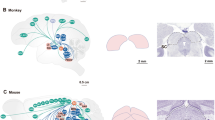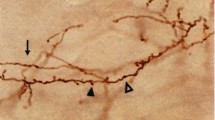Abstract
The present study was performed to clarify whether or not structural plasticity of synaptic connections underlies classical conditioning mediated by the red nucleus (RN) in the cat. Conditioned forelimb flexion is established by pairing electrical conditioned stimuli (CS), applied to corticorubral fibers at the cerebral peduncle (CP), with a forelimb skin shock (the unconditioned stimulus, US), but not by applying the CS alone or by pairing the CS and US at random intervals. In our previous study, it was shown that the firing probability of rubrospinal neurons (RN neurons) in response to the CS was well correlated with acquisition of the conditioned forelimb flexion and that the primary site of neural change underlying establishment of the conditioned forelimb flexion was suggested to be at corticorubral synapses. In the present study, we investigated corticorubral excitatory postsynaptic potentials evoked by CP stimulation (CP-EPSPs), in order to identify the neuronal mechanism underlying establishment of classical conditioning. In normal cats, CP-EPSPs had a typical slow-rising phase, which has been attributed to the distal location of corticorubral synapses on the dendrites of RN neurons. In contrast, in animals that received paired conditioning, subsequent CP stimulation evoked potentials with a fast-rising time course. In control groups of cats that received CS alone, CS randomly paired with the US, or only the same surgical operations as the conditioned animals, most of the CP-EPSPs displayed slow-rising EPSPs that similar to those observed in normal cats. The mean time from onset to peak of the potentials in the conditioned animals was significantly shorter than that seen in other groups. Therefore, the appearance of a fast-rising potential correlates well with acquisition of the conditioned forelimb flexion. The amplitude of the fast-rising potential was gradually changed with stimulus intensity. It had a short onset latency following CP stimulation (0.9 ms), which was similar to that of the slow-rising EPSP in normal cats. It followed high-frequency stimulation up to 100 Hz. These results suggest that the newly appearing, fast-rising potential was a monosynaptically evoked EPSP. Fast-rising EPSPs were also induced by stimulation of the sensorimotor cortex (SM). Since the SM-EPSP was occluded by the CP-EPSP, the SM cortex is, at least in part, a likely source of fast-rising EPSPs. Fast-rising SM-EPSPs were also observed at the unitary level. The SM-EPSPs in the conditioned animals exhibited somatotopical representation in their cortical origin, as has been described in normal cats. The electrotonic length was calculated from the voltage transient responses to current steps injected into the RN neurons. There was no concomitant change in the electrotonic length following the classical conditioning. Furthermore, the fastrising EPSPs were often observed as if they were superposed on the slow-rising EPSPs that were observed in normal animals. These observations suggest that the appearance of fast-rising EPSPs is due to the formation of new corticorubral synapses on the somata or the proximal dendrites of the RN neurons, and not as a result of a reduction in the electrotonic length of the RN neurons. The present study provides further evidence that this type of structural plasticity of synaptic connections underlies establishment of the classically conditioned forelimb flexion.
Similar content being viewed by others
References
Amalric M, Conde H, Dormont JF, Farin D, Schmied A (1983) Cat red nucleus changes of activity during the motor initiation in a reaction time task. Exp Brain Res 52:210–218
Bailey CH, Chen M (1983) Morphological basis of long-term habituation and sensitization in Aplysia. Science 220:91–93
Bailey CH, Chen M (1988) Long-term memory in Aplysia modulates the total number of varicosities of single identified sensory neurons. Proc Natl Acad Sci USA 85:2373–2377
Bailey CH, Chen M (1989) Time course of structural changes at identified sensory neuron synapses during long-term sensitization in Aplysia. J Neurosci 9:1774–1780
Bekkers JM, Stevens CF (1989) NMDA and non-NMDA receptors are co-localized at individual excitatory synapses in cultured rat hippocampus. Nature 341:230–233
Brown LT (1974) Corticorubral projections in the rat. J Comp Neurol 154:149–168
Brown TH, Johnston D (1983) Voltage-clamp analysis of mossy fiber synaptic input to hippocampal neurons. J Neurophsiol 50:487–507
Cajal SR (1911) Histologie du systéme nerveux de l'homme et des vertébrés, vol 2, Moloine, Paris
Cheny PD, Mewes K, Fetz EE (1988) Encoding of motor parameters by corticomotoneuronal (CM) and rubromotoneuronal (RM) cells producing postspike facilitation of forelimb muscles in the behaving monkey. Behav Brain Res 28:181–191
Cotman CW, Nieto-Sampedro N, Harris EW (1981) Synapse replacement in the nervous system of adult vertebrate. Physiol Rev 61:684–784
Eccles JC, Rantucci T, Scheid P, Taborikova H (1975) Somatotopic studies on red nucleus: spinal projection level and respective receptive fields. J Neurophysiol 38:965–980
Fetz EE, Gustafsson B (1983) Relation between shapes of postsynaptic potentials and changes in firing probability of cat motoneurones. J Physiol (Lond) 341:387–410
Finkel AS, Redman SJ (1983) The synaptic current evoked in cat spinal motoneurones by impulses in single group Ia axons. J Physiol (Lond) 342:615–632
Fujito Y, Tsukahara N, Oda Y, Yoshida M (1982) Formation of functional synapses in the adult cat red nucleus from the cerebrum following cross-innervation of forelimb flexor and extensor nerves. 2. Analysis of newly appeared synaptic potentials. Exp Brain Res 45:13–18
Gibson AR, Houk JC, Kohlerman NJ (1985) Relation between red nucleus discharge and movement parameters in trained macaque monkeys. J Physiol (Lond) 358:551–570
Greenough WT (1984) Possible structural substrate of plastic neural phenomena. In: Lynch G, McGaugh JL, Weinberger N (eds) Neurobiology of learning and memory. Guilford, New York, pp 470–478
Greenough WT, Bailey CH (1988) The anatomy of a memory: convergence of results across a diversity of tests. Trends Neurosci 11:142–147
Hebb DO (1949) The organization of behavior: a neurophysiological theory. Wiley, New York
Hestrin S, Nicoll RA, Perkel DJ, Sah P (1990) Analysis of excitatory synaptic action in pyramidal cells using whole-cell recording from rat hippocampal slices. J Physiol (Lond) 422:203–225
Jack JJB, Redman SJ (1971) An electrical description of the motoneurone, and its application to the analysis of synaptic potentials. J Physiol (Lond) 215:321–352
Jeneskog T, Padel Y (1984) An excitatory pathway through dorsal columns to rubrospinal cells in the cat. J Physiol (Lond) 353:355–373
Johnston D, Brown TH (1983) Interpretation of voltage-clamp measurements in hippocampal neurons. J Neurophysiol 50:464–486
Kennedy PR (1987) Parametric relationships of individual digit movements to neuronal discharges in primate magnocellular red nucleus. Brain Res 417:185–189
King JS, Martin GF, Conner JB (1972) A light and electron microscopic study of corticorubral projections in the opossum, Didelphis marsupialis virginiana. Brain Res 38:251–265
Konorski J (1948) Conditioned reflexes and neuron organization. Cambridge University Press, London
Kuypers HGJM (1981) Anatomy of the descending pathways. In: Motor control. (Handbook of physiology, sect 1, vol 2) Am Physiol Soc, Bethesda pp 597–666
Lawrence DG, Kuypers HGJM (1968) The functional organization of the motor system in the monkey. 2. The effects of lesions of the descending brain-stem pathways. Brain 91:15–36
Llinás R, Nicholson C (1971) Electrophysiological properties of dendrites and somata in alligator purkinje cells. J Neurophysiol 34:532–551
Martin JH, Ghez C (1988) Red nucleus and motor cortex: parallel motor systems for the initiation and control of skilled movement. Behav Brain Res 28:217–223
Martin JH, Ghez C (1991) Task-related coding of stimulus and response in cat red nucleus. Exp Brain Res 85:373–388
Murakami F, Tsukahara N, Fujito Y (1977) Properties of the synaptic transmission of the newly formed cortico-rubral synapses after lesion of the nucleus interpositus of the cerebellum. Exp Brain Res 30:245–258
Murakami F, Katsumaru H, Saito K, Tsukahara N (1982) A quantitative study of synaptic reorganization in red nucleus neurons after lesion of the nucleus interpositus of the cat: an electron microscopic study involving intracellular injection of horseradish peroxidase. Brain Res 242:41–53
Murakami F, Katsumaru H, Maeda J, Tsukahara N (1984) Reorganization of corticorubral synapses following cross-innervation of flexor and extensor nerves of adult cat: a quantitative electron microscopic study. Brain Res 306:299–306
Murakami F, Etoh M, Kawato M, Oda Y, Tsukahara N (1986) Synaptic currents at interpositorubral and corticorubral excitatory synapses measured by a new iterative single-electrode voltage-clamp method. Neurosci Res 3:590–605
Murakami F, Higashi S, Katsumaru H, Oda Y (1987) Formation of new corticorubral synapses as a mechanism for classical conditioning in the cat. Brain Res 437:379–382
Nishioka S, Nakahama H (1973) Peripheral somatic activation of neurons in the cat red nucleus. J Neurophysiol 36:296–307
Oda Y, Kuwa K, Miyasaka S, Tsukahara N (1981) Modification of rubral unit activities during classical conditioning in the cat. Proc Japan Acad [B] 57:402–405
Oda Y, Kishida H, Ito M, Nagatsu I (1987) Modification of rubral cell activity underlies associative classical conditioning induced by paired stimulation of corticorubral fibers and locus coeruleus. Soc Neurosci Abstr 13:839
Oda Y, Ito M, Kishida H, Tsukahara N (1988) Formation of new cortico-rubral synapses as a possible mechanism for classical conditioning mediated by the red nucleus in cat. J Physiol (Paris) 83:207–216
Padel Y, Armand J, Smith AM (1972) Topography of rubrospinal units in the cat. Exp Brain Res 14:363–371
Padel Y, Smith AM, Armand J (1973) Topography of projections from the motor cortex to rubrospinal units in the cat. Exp Brain Res 17:315–332
Padel Y, Sybirska E, Bourbonnais D, Vinay L (1988) Electrophysiological identification of a somatesthetic pathway to the red nucleus. Behav Brain Res 28:139–151
Purpura DP (1967) Comparative physiology of dendrites. In: Quarton GC, Melnechuk T, Schmitt FO (eds) The neurosciences. Rockefeller University Press, New York, pp 372–393
Rall W (1964) Theoretical significance of dendritic tree for neuronal input-output relations. In: Reiss RF (eds) Neuronal theory and modeling. Stanford University Press, Stanford, pp 73–97
Rall W (1969) Time constants and electrotonic length of membrane cylinders and neurons. Biophys J 9:1483–1508
Sato S, Tsukahara N (1976) Some properties of the theoretical membrane transients in Rall's neuron model. J Theor Biol 63:151–163
Snider RS, Niemer WT (1964) A stereotaxic atlas of the cat brain. The University of Chicago Press, Chicago
Smith AM (1970) The effects of rubral lesions and stimulation on conditioned forelimb flexion responses in the cat. Physiol Behav 5:1121–1126
Spencer WA, Kandel ER (1961) Electrophysiology of hippocampal neurons. 4. Fast prepotentials. J Neurophysiol 24:272–285
Tsukahara N (1981) Synaptic plasticity in the mammalian central nervous system. Annu Rev Neurosci 4:351–379
Tsukahara N, Kosaka K (1968) The mode of cerebral excitation of red nucleus neurons. Exp Brain Res 5:102–117
Tsukahara N, Oda Y (1981) Appearance of new synaptic potentials at cortico-rubral synapses after the establishment of classical conditioning. Proc Japan Acad [B] 57:398–401
Tsukahara N, Toyama K, Kosaka K (1967) Electrical activity of red nucleus neurons investigated with intracellular microelectrodes. Exp Brain Res 4:18–33
Tsukahara N, Hultborn H, Murakami F, Fujito Y (1975a) Electrophysiological study of formation of new synapses and collateral sprouting in red nucleus neurons after partial denervation. J Neurophysiol 38:1359–1372
Tsukahara N, Murakami F, Hultborn H (1975b) Electrical constants of neurons of the red nucleus. Exp Brain Res 23:49–64
Tsukahara N, Oda Y, Notsu T (1981) Classical conditioning mediated by the red nucleus in the cat. J Neurosci 1:72–79
Tsukahara N, Fujito Y, Oda Y, Maeda J (1982) Formation of functional synapses in the adult cat red nucleus from the cerebrum following cross-innervation of forelimb flexor and extensor nerves. 1. Appearance of new synaptic potentials. Exp Brain Res 45:1–12
Vinay L, Padel Y (1990) Spatio-temporal organization of the somatesthetic projections in the red nucleus transmitted through the spino-rubral pathway in the cat. Exp Brain Res 79:412–426
Voneida TJ (1990) The effect of rubrospinal tractotomy on a conditioned limb response in the cat. Soc Nerosci Abstr 20:270
Author information
Authors and Affiliations
Rights and permissions
About this article
Cite this article
Ito, M., Oda, Y. Electrophysiological evidence for formation of new corticorubral synapses associated with classical conditioning in the cat. Exp Brain Res 99, 277–288 (1994). https://doi.org/10.1007/BF00239594
Received:
Accepted:
Issue Date:
DOI: https://doi.org/10.1007/BF00239594




